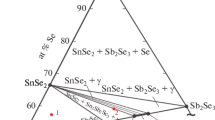Abstract
Mössbauer spectroscopy and X-ray diffraction studies performed on powdered samples of Sn−Se alloys allowed us to determine the influence of the chalcogenide bonds in the tin oxidation mechanism. The weak bonds present in the SnSe2 compound increase the tin oxidation kinetics, an effect which is not found in pure tin samples maintained in the same conditions.
Similar content being viewed by others
References
H.G. Chakurov and G.G. Gospodinov, Bulg. J. Phys. 9 (1982) 259.
V.I. Goldanski and R.H. Herber,Chemical Applications of the Mössbauer Effect (Academic Press, New York, 1968) p. 30.
K.P. Mitrofanov, V.P. Gor'kov, M.V. Plotnikova and S.I. Reiman, Nucl. Instr. Meth. 155 (1978) 539.
S. Taneja, A. Dwight, W. Harper, C. Kimball and C. Wood, Phys. and Chem. of Glasses 13, 5 (1972) 153.
V. Fano and I. Ortalli, J. Chem. Phys. 61 (1974) 5017.
G. Busch, C. Fröhlich and F. Hulliger, Helv. Phys. Acta 34 (1961) 359.
Author information
Authors and Affiliations
Rights and permissions
About this article
Cite this article
Duhalde, S., Arcondo, B., Nassif, E. et al. Tin oxidation mechanism in the Sn−Se alloy. Hyperfine Interact 39, 165–172 (1988). https://doi.org/10.1007/BF02394449
Received:
Revised:
Issue Date:
DOI: https://doi.org/10.1007/BF02394449




